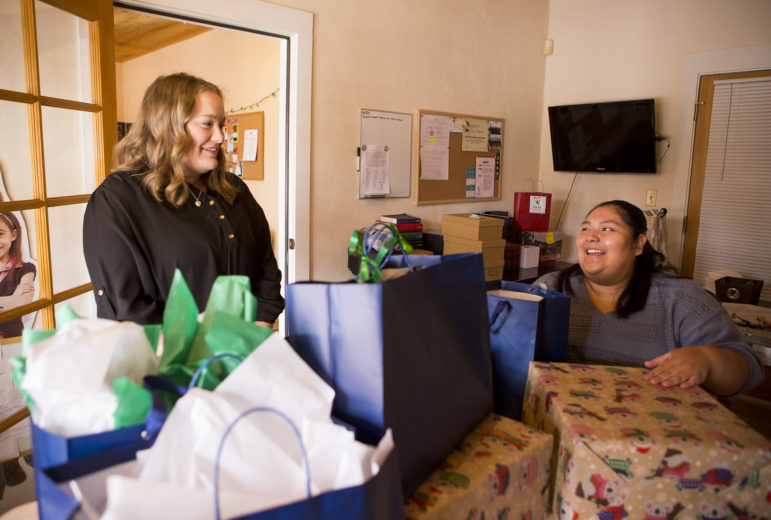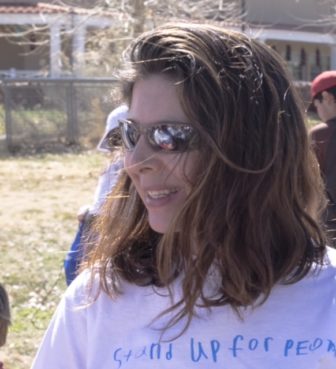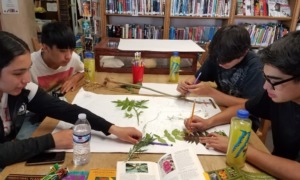
Olivia Harlow/The New Mexican
Jessica Henderson (left) and Veronica Krupnik, with the state First Judicial District’s CASA program, organize holiday gifts for foster youth ages 14 to 18. Krupnick, 23, the youth foster advocate, was placed in seven foster care settings as a child before age 10. Landing a job with CASA in October 2018 “did feel like fate, like a full circle,” said Krupnick, who also serves as a volunteer advocate.
SANTA FE, N.M. — Annie Rasquin believes in difficult conversations with her staff and volunteers, especially when the complex needs of a foster youth require immediate attention.
“In the middle of the night, you’re taken out of your house and the cliché about throwing everything in a garbage bag is true. You have a new home with new rules and new ways of doing things. You’re disconnected from your friends and your pets, and sometimes your own siblings and your parents,” said Rasquin, executive director of Court Appointed Special Advocates (CASA) for Children, First Judicial District in Santa Fe. “Locally, there’s a lack of foster homes, which is a huge issue because these kids end up separated from everyone and everything they know and sometimes far away.”
The New Mexico Children, Youth, and Families Department (CYFD), the state child protective services organization tasked with keeping kids and families out of harm’s way, is often the default scapegoat when discussing the bleak child well-being outcomes. But there’s a bigger picture to consider, Rasquin explained.

CASA First
Annie Rasquin
“I think we need to be very optimistic, but we also need to look differently at every aspect of this system, whether it’s respondent attorneys, guardian ad litems or CYFD, where we want to know that they have appropriate caseloads, training and support, and retention of staff,” she said. She estimates there are currently 150 youth in care in the First Judicial District. “We’re not going to play the blame game. We are part of the system.”
In 2017 and 2018, New Mexico placed last in the country for overall child well-being in the Annie E. Casey Foundation Kids Count report. The state’s child abuse numbers also increased and currently lingers at approximately twice the national average. However, improving the state’s child welfare systems appears to be at the forefront of some lawmakers’ agendas. In 2019, a number of systematic child welfare and foster care reforms were implemented at the federal and state levels.
CASA First Judicial District, which serves the cities of Santa Fe, Los Alamos and Española as well as Rio Arriba County, recruits, trains and supervises court-appointed volunteers who are matched with a youth in care. But volunteers for CASA, a national nonprofit with chapters all over the country, become much more than legal representation in court.
“The system is overburdened and these kids get lost so we have an adult that really gets to know them and pays attention to them,” Rasquin said. “What these kids tell us is that there are people in and out of their lives all of the time. No one is consistent and CASA ends up being the only consistent. We feel like we’re lifesavers for these kids.”
CASA First Judicial District gets by on a modest budget, three paid staff members and approximately 60 volunteers who are matched with one or two cases. Each volunteer must complete an initial intensive training session as well as ongoing annual instruction that includes a course on historical trauma for Native Americans and educational partnerships with Solace Crisis Treatment Center, a Santa Fe-based sexual violence prevention and treatment facility.
CASA’s goal is reunifying the youth in care with their family as long as the child is returning to a safer environment, but sometimes that’s impossible. If a youth bounces around the system until they’re no longer eligible for services, they’re susceptible to incarceration, homelessness and premature death.
“When the foster child ages out, the outcomes are truly horrific,” Rasquin said. A Hilton Foundation report shows that 50% of youth in care experience homelessness within the first four years of leaving foster care. During the 2019 New Mexico Legislature, lawmakers extended foster youths’ access to financial, educational and social support services from age 18 to 21.
Rasquin says the state, which recently created the Early Education and Care Department, also needs to focus on the state’s youngest kids.
[Related: New Mexicans See Foster Care Challenges, But Are Encouraged by Changes]
[Related: Lack of Affordable Housing, Enough Foster Families Hurt Taos, NM, Area]
[Related: Provider In Las Cruces, NM, Left Stretched Thin After 2013 Ruling]
[Related: Carlsbad, NM, Oil Windfall Makes It Harder to Keep Caseworkers]
“About 40 to 60% of kids coming to foster care are birth to 5, and a lot of brain development happens early on, which includes relationship patterning and response to toxic stress patterns,” she said.
CASA First Judicial District includes CASITAs, or Court Appointed Special Infant Toddler Advocates. These volunteers boast specialized training in early childhood development, infant mental health concepts and the impacts of early toxic stress on infants and babies.
Rasquin and her staff are always looking for opportunities to help volunteers connect the dots between cultural and equality issues with multigenerational trauma considerations in order to help understand a foster youth’s struggles. The staff recently started a book club and picked Bryan Stevenson’s “Just Mercy: A Story of Justice and Redemption,” which discusses the country’s mass incarceration system and its relationship to race.
Rasquin says it’s not always easy repatterning a volunteer’s thought process, but it’s worth it, especially when a foster youth’s well-being is at stake. “Sometimes it just takes one person to believe in you and be there with you.”
This story is part of a Youth Today project on foster care in New Mexico. It’s made possible in part by the May and Stanley Smith Charitable Trust. Youth Today is solely responsible for the content and maintains editorial independence.





























